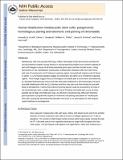| dc.contributor.author | Gostjeva, Elena V. | |
| dc.contributor.author | Fomina, Janna N. | |
| dc.contributor.author | Darroudi, Firouz | |
| dc.contributor.author | Gruhl, Amanda Natalie | |
| dc.contributor.author | Thilly, William G | |
| dc.date.accessioned | 2015-10-30T15:21:04Z | |
| dc.date.available | 2015-10-30T15:21:04Z | |
| dc.date.issued | 2010-12 | |
| dc.date.submitted | 2010-08 | |
| dc.identifier.issn | 01654608 | |
| dc.identifier.uri | http://hdl.handle.net/1721.1/99524 | |
| dc.description.abstract | Metakaryotic cells and syncytia with large, hollow, bell-shaped nuclei demonstrate symmetrical and asymmetrical amitotic nuclear fissions in microanatomical positions and numbers expected of stem cell lineages in tissues of all three primordial germ layers and their derived tumors. Using fluorescence in situ hybridization, mononuclear metakaryotic interphase cells have been found with only 23 centromeric and 23 telomeric staining regions. Syncytial bell-shaped nuclei found approximately during weeks 5–12 of human gestation display 23 centromeric and either 23 or 46 telomeric staining regions. These images suggest that (1) homologous chromatids pair at centromeres and telomeres, (2) all paired telomeres join end-to-end with other paired telomeres in all mononuclear and some syncytial metakaryotic cells, and (3) telomere junctions may open and close during the syncytial phase of development. Twenty-three telomeric joining figures could be accounted by 23 rings of one chromatid pair each, a single pangenomic ring of 23 joined chromatid pairs, or any of many possible sets of oligo-chromatid pair rings. As telomeric end-joining may affect peri-telomeric gene expression, a programmed sequence of telomeric end-joining associations in metakaryotic stem cells could guide developmental arboration and errors in, or interruptions of, this program could contribute to carcinogenesis. | en_US |
| dc.description.sponsorship | National Institute of Environmental Health Sciences | en_US |
| dc.description.sponsorship | United Therapeutics, Inc. | en_US |
| dc.language.iso | en_US | |
| dc.publisher | Elsevier | en_US |
| dc.relation.isversionof | http://dx.doi.org/10.1016/j.cancergencyto.2010.08.015 | en_US |
| dc.rights | Creative Commons Attribution | en_US |
| dc.rights.uri | http://creativecommons.org/licenses/by-nc-nd/4.0/ | en_US |
| dc.source | PMC | en_US |
| dc.title | Human fetal/tumor metakaryotic stem cells: pangenomic homologous pairing and telomeric end-joining of chromatids | en_US |
| dc.type | Article | en_US |
| dc.identifier.citation | Gruhl, Amanda N., Elena V. Gostjeva, William G. Thilly, Janna N. Fomina, and Firouz Darroudi. “Human Fetal/tumor Metakaryotic Stem Cells: Pangenomic Homologous Pairing and Telomeric End-Joining of Chromatids.” Cancer Genetics and Cytogenetics 203, no. 2 (December 2010): 203–208. | en_US |
| dc.contributor.department | Massachusetts Institute of Technology. Department of Biological Engineering | en_US |
| dc.contributor.department | MIT Edgerton Center | en_US |
| dc.contributor.mitauthor | Gruhl, Amanda Natalie | en_US |
| dc.contributor.mitauthor | Gostjeva, Elena V. | en_US |
| dc.contributor.mitauthor | Thilly, William G. | en_US |
| dc.relation.journal | Cancer Genetics and Cytogenetics | en_US |
| dc.eprint.version | Author's final manuscript | en_US |
| dc.type.uri | http://purl.org/eprint/type/JournalArticle | en_US |
| eprint.status | http://purl.org/eprint/status/PeerReviewed | en_US |
| dspace.orderedauthors | Gruhl, Amanda N.; Gostjeva, Elena V.; Thilly, William G.; Fomina, Janna N.; Darroudi, Firouz | en_US |
| dc.identifier.orcid | https://orcid.org/0000-0002-4232-261X | |
| dc.identifier.orcid | https://orcid.org/0000-0003-2581-6092 | |
| mit.license | PUBLISHER_CC | en_US |
| mit.metadata.status | Complete | |
